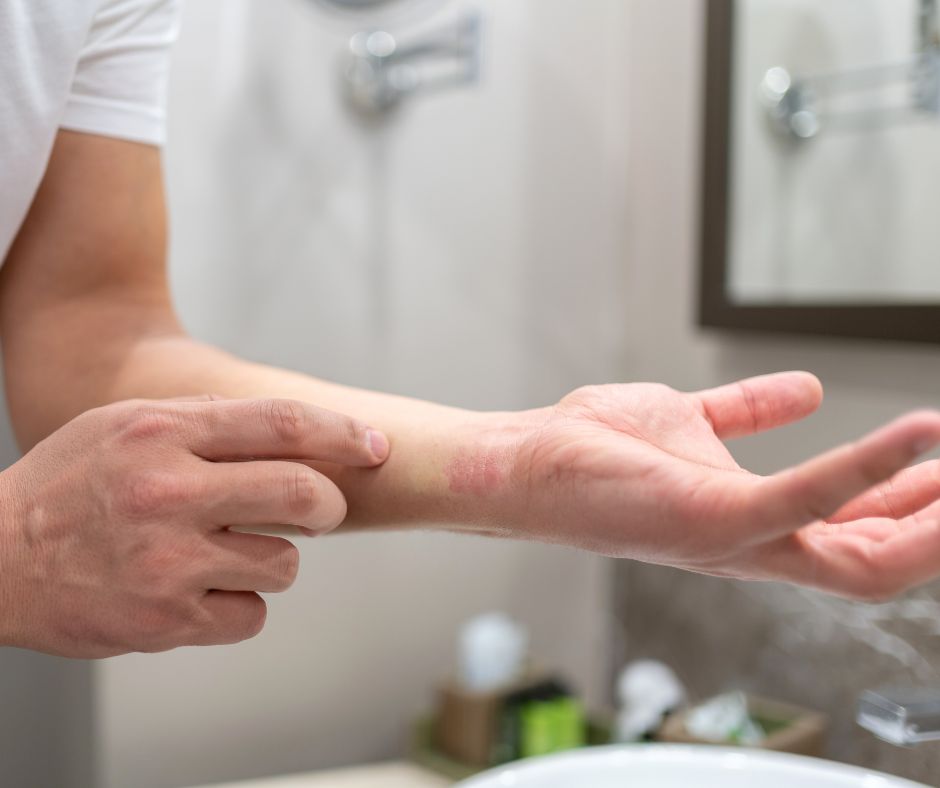Peanut butter, shellfish, pollen – these common allergies are a regular part of conversation and, let’s face it, the occasional punchline at family gatherings. But did you know there are some rare and surprising allergies that are harder to avoid than skipping the seafood buffet – like those people who are allergic to water? Yes, H2-Oh-no!
While these rare allergies might sound like something out of a science fiction movie, they are very real and affect a small number of people worldwide. In this blog, we’ll dive into the fascinating world of five of the rarest allergies. Prepare to be amazed, informed, and just a little bit more grateful for your health as we explore these unusual allergic reactions.
Water Allergy (Aquagenic Urticaria)
Aquagenic urticaria, or an allergy to water, is a rare condition in which contact with water causes itchy, painful hives on the skin. This extremely rare allergy has only been reported around 50 times in medical history, and experts are still unsure exactly how or why it occurs. A 2022 study found that the condition primarily affects women and can develop at any age, though the average onset is 19 years old.
Aquagenic urticaria can be triggered by any type or temperature of water, whether tap, distilled, seawater, or even sweat and tears. Most individuals with this condition can drink water without issue, but in rare cases it may cause a reaction on the lips or mouth.
Symptoms usually begin within 30 minutes of exposure and can include:
- Hives that appear on the upper arms and torso
- Itching, burning or stinging sensation on the skin
- Wheezing or shortness of breath
There is no cure for aquagenic urticaria. Treatment options include antihistamines and topical medications.
Cold Allergy (Cold Urticaria)
Cold urticaria is a rare allergy in which a sudden exposure to cold temperatures triggers an allergic reaction. People with this allergy can experience a wide range of symptoms after exposure to cold air or water, drinking cold beverages, touching cold objects, or even eating ice cream. This condition affects about 6 out of every 10,000 people and occurs most frequently in young adults. The direct cause isn’t known, but some experts believe it may be linked to underlying health conditions or infections.
Symptoms vary widely based on the place of cold exposure and the severity of your reaction.
- Red, itchy skin and welts on areas of skin exposed to cold
- Swelling of hands while holding cold objects
- Swelling of lips when consuming cold food or drinks
- Symptoms get worse as the skin warms
In severe cases, reactions can include a whole-body response, swelling of the tongue or throat, and even anaphylactic shock. Treatments for cold urticaria include minimizing cold exposure and taking antihistamines.
Sun Allergy (Solar Urticaria)
Solar urticaria is a rare allergic reaction to sunlight. People with this condition experience hives, blisters, and itchy welts on areas of the skin that are exposed to the sun (not to be confused with a common sunburn.) Less than 650 confirmed cases have been reported worldwide, occurring mostly in light-skinned women in their mid-30s. Unlike other types of sun allergy, solar urticaria is a chronic lifelong condition.
Symptoms occur within minutes of sun exposure and are usually confined to areas of skin that are directly exposed. The more skin that is exposed to sunlight, the more serious the reaction can be.
- Blisters or hives
- Clusters of tiny bumps that may merge into larger red patches
- Pain or itching
- Redness
- Scaling, crusting or bleeding
Symptoms typically begin to fade when sun exposure ends and clear completely within 24 hours. Management includes avoiding sun exposure, wearing sunscreen, and taking antihistamines for symptom control.
Sweat Allergy (Cholinergic Urticaria)
Cholinergic urticaria is a type of skin allergy triggered by heat and your own sweat. Technically classified as an autoimmune response, this condition causes temporary hives on the skin triggered by increased body temperature and sweating. Mild forms of the condition are common and usually harmless, but some people have severe reactions that can be challenging to manage. It typically affects young adults and can be exacerbated by various factors, including heat, stress, eating spicy foods, and physical activity.
Symptoms:
- Itching and/or stinging pain
- Redness
- Papular whealing (1-4 mm)
- Anaphylaxis
Treatment for cholinergic urticaria may include medications like antihistamines and beta-blockers. Lifestyle changes such as avoiding spicy foods and minimizing activities that cause sweating can also be helpful.
Human Touch (Dermatographism)
Dermatographism, also known as ‘skin writing’, is a form of physical urticaria where minor pressure or scratches on the skin cause raised, red welts and localized hives. This condition is the most common form of physical urticaria, affecting about 2-5% of the population. It can be triggered by stress, infections, or certain medications and is more commonly seen in younger individuals. People with other skin conditions like eczema or psoriasis are at greater risk.
Dermatographism is usually harmless, but severe cases can affect your quality of life. Symptoms usually appear within minutes and may last for hours to days.
- Raised, red lines or welts where the skin has been scratched or pressed
- Itching and discomfort
- Swelling
- Welts from friction
Dermatographism usually responds well to antihistamines. Prevention measures include using mild soaps and detergents, keeping scratching to a minimum, and using a daily skin moisturizer.
If you or someone you know is dealing with allergies, common or rare, it’s essential to seek proper medical advice and treatment. At America’s Best Care Plus, we specialize in compounded sublingual allergy drops that can help manage and treat various allergies. Learn more about our services and how we can help you live a more comfortable, allergy-free life. Visit our website or contact us today!

